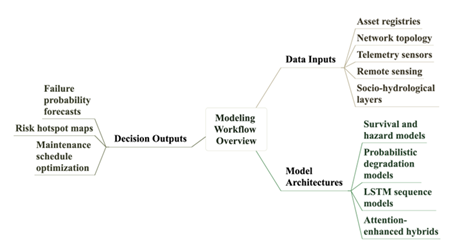Lifecycle Vulnerability in Urban Water Infrastructure for Predictive Maintenance Planning
Main Article Content
Abstract
This paper presents a taxonomy-driven framework for lifecycle vulnerability mapping and predictive maintenance in urban water utilities under aging buried assets and budget constraints. Current planning assumes homogeneous conditions, limiting risk-aware scheduling and the integration of exposure, degradation, and failure-mode evidence. The framework integrates criticality indices, rule-based failure typologies, survival and hazard models, probabilistic degradation, and Long Short-Term Memory (LSTM) sequence models, with uncertainty quantification and feature attribution. Data sources include asset registries, network topology, telemetry, remote sensing, and socio-hydrological layers, harmonized with documented provenance and access controls. Outcomes include simulated asset-state trajectories, annual failure probabilities, risk hotspot maps transformed into ranked interventions, and schedule optimization under crew and budget constraints; model quality is assessed with Root Mean Squared Error (RMSE), Mean Absolute Error (MAE), and coefficient of determination (R2) using temporal splits, back casting, and cross-validation with 95 percent confidence bounds. Sensitivity analyses examine budget limits, model variants, and nonstationary climate and land-use scenarios. Because many results are simulation-derived and labels are sparse, effects are reported qualitatively and utility-specific magnitudes may vary. The contribution is a unified, auditable workflow that links forecasting, risk, and cost into actionable schedules with transparent uncertainty. Practically, the framework enables planners and policymakers to prioritize interventions that mitigate failure risk while smoothing lifecycle costs under real-world constraints.
Article Details

This work is licensed under a Creative Commons Attribution-ShareAlike 4.0 International License.

